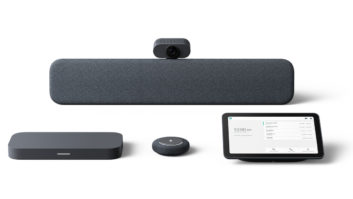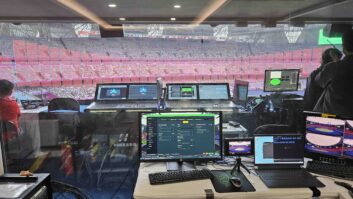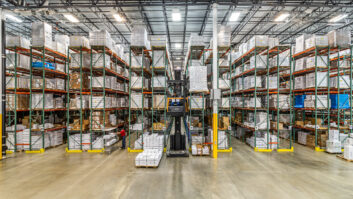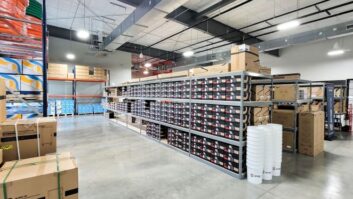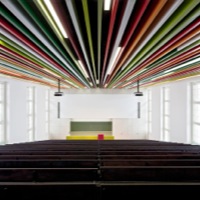
Directivity and discreetness: above all, it is arguably these two requirements that have driven the evolution of install-oriented speaker systems for the past 10 years or more. As expectations of accurate sound reinforcement have blossomed, so too has architects’ and designers’ influence on the specification of audio equipment – a development that has prompted an unprecedented awareness of aesthetic impact.
The emergence of beam-steering as a major technological trend has proven to be a crucial asset in this regard. Aesthetically, it allows designers to achieve significant flexibility in terms of speaker placement, paving the way for a new generation of visually unobtrusive installations. In terms of sound quality, it delivers a bandwidth and SPL conducive to installations in houses of worship and other highly reverberant spaces where vocal clarity is a must – although many of the more recent systems are adept at handling music, too.
Despite its ubiquity, the science of beam-steering has (to put it mildly) not always been discussed in a manner that is accessible to the non-specialist. As concisely as possible, this article aims to discuss beam-steering’s primary strengths with reference to ‘conventional’ line array, and to consider whether it’s a technology that has now reached full fruition.
The beam-steering goldrush
Remarkably, it is now more than 15 years since the introduction of the first major commercial system – Duran Audio’s Axys Intellivox – initiated a beam-steering goldrush that has gone on to yield Renkus-Heinz’s Iconyx and Tannoy’s QFlex, among numerous other popular systems. But although products marketed as beam-steering systems abound, anecdotal evidence suggests a not insignificant knowledge shortfall about the technology’s principles and benefits.
Arguably the first question that needs to be addressed is ‘why beam-steering over conventional line array’? As regards high SPL, music and entertainment-oriented applications in auditoria and more sizeable conference venues, the dominance of concert/touring-style line-array systems is pretty much beyond question. But for smaller facilities in which the primary requirements are vocal clarity and minimal background music reproduction, passive column line arrays have more than proven their worth… haven’t they?
“Passive columns have certainly become much better performing recently, with attention paid to full frequency control,” notes Graham Hendry, TC Group’s VP of AET Group (Applications Engineering & Training). For less challenging spaces, they can often provide an entirely acceptable solution. “Not every application requires digital beam-steering,” he continues. “If you utilise a good performing, well-behaved passive column that ‘fits’ the space then you will achieve the same results that beam-steering affords for a fraction of the price.”
But, as Hendry also observes, beam-steering affords greater flexibility than passive solutions. In a nutshell, the technique is structured around the phase relationships between the sound delivered from a large number of individual loudspeaker drivers. Their output is optimised to produce a beam of sound controllable in the vertical plane. The vast majority of beam-steering solutions are active, employing amplification as well as sophisticated DSP on the separate elements of the array, allowing for the angle of the beam to be adjusted as required.
“With electrical beam-steering, the audience coverage is optimised without wasting output energy on ceilings or open space above the audience. [That’s] thanks to the vertical steering and beam control, and all this without mechanical tilt or shape of the loudspeaker array. This enables loudspeaker placements according to architectural needs without acoustic compromises,” says Martijn van Overveld, product marketing manager public address & voice alarm at Bosch Security Systems.
As Overveld hints, the principal benefits of this approach are visual unobtrusiveness and control of coverage. “DSP steerable columns can be flush-mounted against a wall, thus becoming potentially almost invisible,” says Xavier Meynial, founder/technical director of Active Audio, which manufactures the StepArray DSP steerable column loudspeaker. “Moreover, changing the directivity of DSP-steerable columns can be done simply by altering the filtering (software) parameters, whereas changing the directivity of line arrays implies changing the layout of the boxes.”The extent to which end-users have flexibility of adjustment continues to differentiate available systems and, consequently, inform marketing campaigns. Fohhn Audio, for example, highlights the ability to adjust its Linea Focus loudspeakers’ vertical sound inclination angle between ±40° and the vertical beam width between 0° and 90° in precise 0.1° steps, in real time, using a single piece of software.
Meanwhile, Tannoy’s QFlex system sports the ability to steer at angles of ±70°, allowing considerable flexibility when choosing mounting locations. “This greater amount of control can be attributed to the fact that every single transducer in a QFlex array has its own dedicated amplifier and DSP channel,” explains Hendry.
Long RTs bequeathed by contemporary design are a further spur to adoption. “Modern architecture is creating more and more buildings consisting of hard materials – glass, marble etc – that result in long reverberation times, so the beam-steering technology products become more often the only electro-acoustical means to handle those situations,” says Oliver Sahm, director tech support at Bosch Communications Systems, which manufactures the Vari-directional Array for environments in which beam-steering is required.
Heard, not seen
Freedom from restrictions pertaining to mounting height heralds other architectural benefits. For aesthetically sensitive installations, there is the possibility of obscuring – indeed, virtually hiding – speaker systems. Not surprisingly, this has resulted in escalating demand for projects in designer-driven environments like airports, railway stations, houses of worship and conference centres.
These applications also resonate with a widespread focus by manufacturers on ensuring compliance with the new generation of PA/VA requirements – a development that is likely to further fuel the ubiquity of beam-steering solutions. “[Tannoy] QFlex products are designed for use in emergency sound systems,” notes TC’s Hendry. “We are now encountering many applications where emergency PA/VA and BGM is shared. More recently, we have been concentrating on the PA/VA element and providing the features required to meet worldwide legislative and safety standards. An ‘intelligent’ solution can be an integral part of the system.”
The PA/VA integration-boosting features now offered with QFlex, continues Hendry, include pilot tone detection, Sentinel SM1 system monitoring (for complete system-wide fault monitoring and reporting), AES connectivity, IP54 certification and constant voltage interfacing.
Multiple contributors also highlight beam-steering’s preset capabilities, but what of the limitations? Historically, as mentioned, many systems have been designed primarily for speech, making them less than suited to applications in which musical reproduction requirements transcend the provision of low-key background sound. But here, too, there is evidence of an increasing scope for the specification of beam-steering systems.
With Tannoy’s much-discussed QFlex, says Hendry, “the main criteria [from the offset] was to be the first digital beam-steered product that allowed full frequency control of a wider band of frequencies than any other. This made it suitable for a wider range of applications intended [to accommodate music reproduction] as well as speech intelligibility.”
Integral here, continues Hendry, is a proprietary and patented high-steering algorithm that allows QFlex to push effective full-range beam control to beyond 12kHz – as opposed to concentrating only on the vocal band. “Efficient deployment of our algorithm ensures very low latency levels, which are useful when syncing with video,” he says. “We are now seeing the early adopters in beam-steering technology following our lead in this department by adding more high-frequency elements to their existing designs, or even adding high-frequency elements for the first time in an effort to achieve better control and a more natural sound.”
The original concept of beam-steering has already evolved to encompass ‘beam-splitting’ – delivering bottom and top beams, as done by Meyer Sound’s CAL, for instance – and ‘beam-shaping’, as employed in Duran Audio’s Intellivox to allow precise adjustment of an array’s near and far field. The consensus view is that this area of technology will continue to mature, but it’s more likely to be a case of evolution than revolution.
“The algorithm we have is very good, so I don’t think there is a lot of work required there. [Already] it can be applied to any loudspeaker array,” says Nick Screen, business development manager at Duran Audio. Instead, he suggests, improvements are more likely to derive from the advent of even better transducers, although he does anticipate the migration to an enhanced DSP platform within the next two to three years.
The market isn’t wanting for new solutions. But away from the R&D sharp end, manufacturers appear increasingly cognisant of the need to offer enhanced training to ensure that customers and end-users maximise their returns from these sophisticated systems. For example, Duran Audio is holding multiple training sessions this year, while Bosch organises regular academy-style sessions for beam-steering design. Many companies report that they work closely with distributors and install customers to help specify the most appropriate systems, producing project simulations employing criteria including desired SPL and architectural factors. Fohhn, meanwhile, is among those to operate specialist facilities – in its case, the SoundLab in Nürtingen, Germany – which allow distributors and customers to compare various systems directly.
A decade-and-a-half on from the introduction of the first high-profile commercial systems, beam-steering is now a universally recognised fixture of install audio. While components will continue to improve, the major hurdle still to be overcome is not so much one of the technology, but of a more profound comprehension of its possibilities among specifiers and end-users.
www.activeaudio.fr
www.boschcommunications.com
www.boschsecurity.com
www.duran-audio.com
www.fohhn.com
www.meyersound.com
www.tannoy.com


